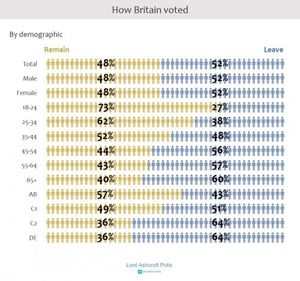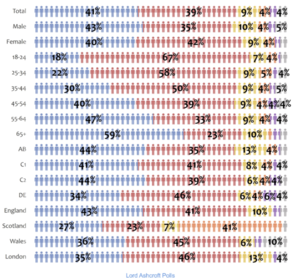Michael Ashcroft
( Politician, Tax Exile, Billionaire) | |
|---|---|
 | |
| Born | Michael Anthony Ashcroft 4 March 1946 Chichester, West Sussex, England |
| Nationality | UK |
| Citizenship | British, Belizean |
| Alma mater | Anglia Ruskin University |
| Spouse | Susan Anstey |
| Member of | The Giving Pledge |
| Party | Conservative Party |
Billionaire former deputy chairman of the Conservative Party | |
Michael Ashcroft, Baron Ashcroft is a former deputy chairman of the Conservative Party who founded Michael A. Ashcroft Associates in 1972 and[1][2] is the 74th richest person in the UK, as ranked by the Sunday Times Rich List 2015, with an estimated fortune of £1.32 billion.[3]
He sat on the Conservative benches of the House of Lords until 2015, having been ennobled as a life peer in 2000. His peerage was controversial due to his status as tax exile.[4] The Cabinet Office stated that he would take up permanent residence in the UK for tax purposes, however it was revealed a decade later that he had not done so.[5]
Ashcroft holds dual British and Belizean nationality, and is a belonger of the Turks and Caicos Islands.[6]
Pollster
Lord Ashcroft Polls published detailed analyses of the turnout from both the 23 June 2016 EU Referendum and the 8 June 2017 General Election. The most glaring statistic revealed by these two votes is that whereas Males and Females voted identically in the EU Referendum (52% Leave and 48% Remain), they were clearly split in the General Election:
- Men voting 43% Conservative and 35% Labour; and,
- Women voting 40% Conservative and 42% Labour.[7]
EU Referendum

On 24 June 2016, Lord Ashcroft Polls published this analysis of the EU Referendum turnout:
The UK has voted to leave the European Union. On referendum day I surveyed 12,369 people after they had voted to help explain the result – who voted for which outcome, and what lay behind their decision.
- The older the voters, the more likely they were to have voted to leave the EU. Nearly three quarters (73%) of 18 to 24 year-olds voted to remain, falling to under two thirds (62%) among 25-34s. A majority of those aged over 45 voted to leave, rising to 60% of those aged 65 or over. Most people with children aged ten or under voted to remain; most of those with children aged 11 or older voted to leave.
- A majority of those working full-time or part-time voted to remain in the EU; most of those not working voted to leave. More than half of those retired on a private pension voted to leave, as did two thirds of those retired on a state pension.
- Among private renters and people with mortgages, a small majority (55% and 54%) voted to remain; those who owned their homes outright voted to leave by 55% to 45%. Around two thirds of council and housing association tenants voted to leave.
- A majority (57%) of those with a university degree voted to remain, as did 64% of those with a higher degree and more than four in five (81%) of those still in full time education. Among those whose formal education ended at secondary school or earlier, a large majority voted to leave.
- White voters voted to leave the EU by 53% to 47%. Two thirds (67%) of those describing themselves as Asian voted to remain, as did three quarters (73%) of black voters. Nearly six in ten (58%) of those describing themselves as Christian voted to leave; seven in ten Muslims voted to remain.
- The AB social group (broadly speaking, professionals and managers) were the only social group among whom a majority voted to remain (57%). C1s divided fairly evenly; nearly two thirds of C2DEs (64%) voted to leave the EU.
- A majority of those who backed the Conservatives in 2015 voted to leave the EU (58%), as did more than 19 out of 20 UKIP supporters. Nearly two thirds of Labour and SNP voters (63% and 64%), seven in ten Liberal Democrats and three quarters of Greens, voted to remain.
- Conservative voters constituted just over three out of every ten remainers, and four in ten leavers. Labour voters made up four in every ten remainers, and two in ten leavers.
- Just under half (43%) of voters said they always knew how they would end up voting or decided more than a year ago. Nearly a quarter (24%) decided in the week before referendum day; and one in ten decided yesterday, or on the day they filled in their postal vote.
- Leave and remain voters were almost equally likely to have decided on the day. Labour and Lib Dem supporters who voted leave were more likely to have decided late than Conservative leavers.
- Nearly half (49%) of leave voters said the biggest single reason for wanting to leave the EU was “the principle that decisions about the UK should be taken in the UK”. One third (33%) said the main reason was that leaving “offered the best chance for the UK to regain control over immigration and its own borders.” Just over one in eight (13%) said remaining would mean having no choice “about how the EU expanded its membership or its powers in the years ahead.” Only just over one in twenty (6%) said their main reason was that “when it comes to trade and the economy, the UK would benefit more from being outside the EU than from being part of it.”
- For remain voters, the single most important reason for their decision was that “the risks of voting to leave the EU looked too great when it came to things like the economy, jobs and prices” (43%). Just over three in ten (31%) reasoned that remaining would mean the UK having “the best of both worlds”, having access to the EU single market without Schengen or the euro. Just under one in five (17%) said their main reason was that the UK would “become more isolated from its friends and neighbours”, and fewer than one in ten (9%) said it was “a strong attachment to the EU and its shared history, culture and traditions.”
- Overall, small majorities of voters thought EU membership would be better for the economy, international investment, and the UK’s influence in the world. Leaving the EU was thought more likely to bring about a better immigration system, improved border controls, a fairer welfare system, better quality of life, and the ability to control our own laws.[8]
June 2017 General Election

On 9 June 2017, Lord Ashcroft Polls reported:
I surveyed over 14,000 people on election day who had already cast their vote to help understand how this unexpected result came about. My poll came very close to reflecting the outcome of the election, with 41% saying they had voted Conservative, 39% Labour, and 9% voted Liberal Democrat (the result in Great Britain has been 43% Conservative, 41% Labour, 7% Lib Dems). The survey found two thirds of those aged 18 to 24 saying they voted Labour, as did more than half of those aged 25 to 34. Voters aged over 55 broke for the Tories.
Labour voters made their minds up much later in the campaign than those who backed the Tories. More than half (57%) of those who voted Labour made their decision in the last month, and more than a quarter (26%) in “the last few days”. Conservatives were more likely to have known how they would vote before the campaign started.
Voters who made up their minds towards the end of the campaign were more likely to vote Labour than Conservative.
The survey found that 82% of those who voted Conservative in 2015 did so again yesterday, with one in ten switching to Labour and one in twenty going to the Lib Dems. Meanwhile, 83% of 2015 Labour voters stayed with their party, with only 9% going to the Conservatives. Half of those who voted Lib Dem last time round did so again this time, as did eight in ten SNP voters. Just over half (57%) of UKIP voters said they had switched to the Tories; fewer than one in five (19%) said they had stayed with their 2015 parties.
Six in ten of those who said they had voted Leave in the EU referendum backed the Conservatives in the general election; a quarter of leavers voted Labour. Only a quarter of Remain voters voted Conservative; just over half (51%) voted Labour, and a quarter of remainers voted Liberal Democrat.
To look at this question the other way round, just over two thirds (68%) of those who voted Conservative said they had voted Leave in the referendum. Just under two thirds (64%) of those who voted Labour said they had voted to remain in the EU, as did nearly eight in ten Liberal Democrats.
Seven in ten Conservative voters said they wanted Brexit to happen as soon as possible. Only 33% of Labour voters said the same; 43% said they would still like to prevent Brexit from happening if possible, as did more than half (56%) of Liberal Democrat voters.
Presented with a list of reasons which might have been behind their vote, Labour, Lib Dem and SNP voters said the most important factor had been that they trusted the motives of the party they chose; next, that they had preferred that party’s promises. Conservative voters had different priorities: their most important reason was thinking the party or its leader would do a better job of negotiating Brexit; followed by the belief that Theresa May would be the best Prime Minister.
Asked unprompted which issues had been the most important in their voting decision, Conservatives were most likely to name Brexit (as were Liberal Democrats), followed by having the right leadership. Labour voters, meanwhile, were most likely to name the NHS and spending cuts. Only 8% of Labour voters named Brexit as the most important issue in their decision, compared to 48% of those who voted Conservative.[9]
References
- ↑ http://news.bbc.co.uk/2/hi/uk_news/politics/696781.stm
- ↑ http://www.bankofengland.co.uk/education/Pages/resources/inflationtools/calculator/flash/default.aspx
- ↑ http://www.thesundaytimes.co.uk/sto/public/richlist/article1240671.ece
- ↑ https://www.theguardian.com/politics/2002/aug/27/uk.conservatives
- ↑ http://news.bbc.co.uk/1/hi/uk_politics/8542744.stm
- ↑ "Lord Ashcroft on his fight for life as he battled with sepsis - and why he will donate £250,000 with your help"
- ↑ "General Election 2017 Analysis Suggests Young Turnout Wasn’t What Produced Shock Result"
- ↑ "How the United Kingdom voted on Thursday… and why"
- ↑ "How did this result happen? My post-vote survey"